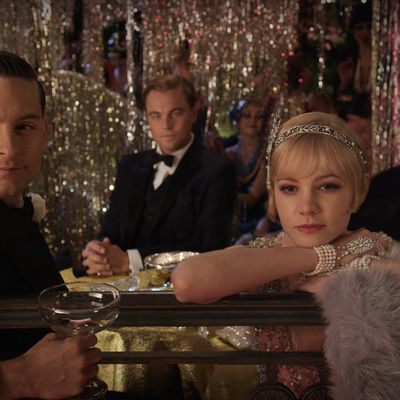
Baz Luhrmann’s The Great Gatsby did not manage to overthrow Iron Man 3 at the box office, but it still made a remarkable $51 million — Luhrmann’s best opening to date. It was also entirely bonkers, full of loud music and strange effects that your high-school English teacher would likely scoff at. Since you surely have an opinion (or five), please join Vulture for the latest meeting of the Monday Morning Movie Club. We have some thoughts about that Lana song, for starters.
Lana Del Rey was created to be in The Great Gatsby.
The parallels are remarkable, actually — a mysterious local celebrity (Long Island or the Internet, depending) known by reputation only? The too-glittering lifestyle? The obviously fake backstory? How did we not realize this before: Lana Del Rey is a Gatsby, all aspiration and projection and doomed fate. So making “Young and Beautiful” the movie’s unofficial anthem is actually a masterstroke, whether or not Luhrmann actually made the connection. (For the record, we thought the rest of the music worked, too. That soundtrack may be shaky as a whole, but the snippets blend in with the rest of Luhrmann’s insane MTV creation.)
How did you feel about Joel Edgerton?
Edgerton has a weirdly prominent place on those Gatsby billboards — even more prominent than, you know, Extremely Famous Person Leonardo DiCaprio. But do we think that he worked as Tom Buchanan in this movie? Here at Vulture, we’re split: Some of us feel that Joey Edge (let’s make that happen) is the film’s standout, while others feel that, even though Edgerton is a talented actor, he just doesn’t have the star power to assert himself as a rival to DiCaprio. Luhrmann originally pursued Ben Affleck for the role (he had to pass because of commitments to Argo), and that would have been worthwhile for the mustache, at least. What might have been!
Words can fly!
It turns out Baz Luhrmann listened to The Great Gatsby — in audiobook form — which explains why Tobey Maguire read large chunks of the book to you throughout the film. It is just how he understands things. In that light, we should almost be grateful for the sentence-length quotes that start zooming around the screen in the third act, straight from Tobey’s typewriter to the sky. Yes, it was reminiscent of a fifth-grade book report, but would you really understand things like “So we beat on, boats against the current, borne back ceaselessly into the past” if they were not spelled out right in front of you? And would Gatsby really be Gatsby without the boats? No.
For once, Jordan is great.
Can we all agree that the breakout star of the film was Aussie newcomer Elizabeth Debicki as the droll Jordan Baker? She’s got the gangly limbs, close-cropped dark hair, and sloe eyes of Rooney Mara, but in a much more fun package. Why is she not signed up for a thousand new Hollywood movies immediately?
But the ADR (rerecorded dialogue) was not so great.
What was WITH the terry-bull ADR in this movie? So many lines were clearly looped in after the fact — over mouth movements that they didn’t even bother to match — that we wondered whether the movie was preemptively releasing its own “Bad Lip Reading” viral video. Like, this is a Baz Luhrmann movie: If they had to fit a line into a place it shouldn’t be, just CGI some falling glitter over the speaker’s face at the proper moment. Done! Easy fix!
Daisy In The Sky With Diamonds
From Kathryn Schulz, in her Gatsby (the book) takedown: “What was Fitzgerald doing instead of figuring out such things about his characters? Precision-engineering his plot, chiefly, and putting in overtime at the symbol factory.” Let us say this for Fitzgerald: At least he did not write a scene in which the sky opens to reveal Daisy’s face floating over the green light, which is the director’s equivalent of running into a theater and yelling “Get it, guys? Do you get it?!?” (We do. Does he?)
Was the 3-D necessary?
You tell us. It seemed pretty useless from where we were sitting, just like the 3-D in Iron Man 3. (The price-gouging technology is really good, though, at making movies much darker than they need to be.) The early party scenes benefit from the approach conversion, what with all of the fireworks and confetti and glitter. But everything after Gatsby throws his beautiful, beautiful shirts up in the air is a wash. Luhrmann claims that the 3-D amps up the tension in the climactic scene between Tom and Gatsby and Daisy in the Plaza Hotel, but that sounds like wishful thinking to us. A director can use 3-D to push things in the audience’s face (this year’s Oz the Great and Powerful did that wonderfully and shamelessly), or they can use 3-D to make the movie deeper, to play with depth of field and the placement of faces and objects in the frame. Luhrmann tried the latter and couldn’t pull it off.
Speaking of that Plaza scene …
There are not a lot of surprises in Baz Luhrmann’s The Great Gatsby, but the few that there are stick — like the straight-up decadence of that early Nick-Tom-Myrtle apartment party scene, both story-wise (Tom: “I thought you liked to watch.”) and visually (the superimposition of Nick in the window alongside all of the other windows he’s looking at). But one of our favorite moments, mainly because it felt true and human, was the one immediately after Gatsby explodes in Tom’s face at the Plaza. The two men are grasping each other, and Tom lightly touches his forehead to Gatsby’s. It’s so tender but also such an unexpectedly macho way for Tom to say to his rival, “I just won, old sport.”

